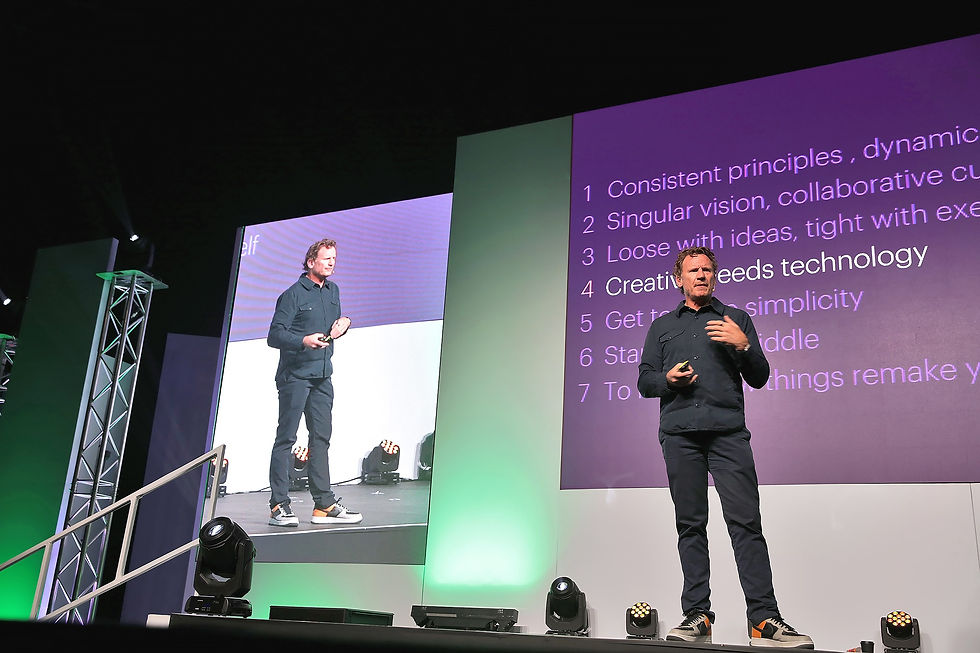
If the Daily Maverick calls it “Africa’s most prestigious marketing conference”, it's a given that V5 Digital would be in attendance, ready to immerse ourselves in unparalleled insights and inspirations at the 2023 Nedbank IMC Conference.
The Integrated Marketing Council (IMC), a platform championing the progression and upliftment of the marketing industry, advocates for this industry’s rightful place at the boardroom table, nurturing the concept that the heartbeat of any business lies in marketing.
Upliftment of the youth is also a priority of the event which V5 Digital as a Pledge 1% participant appreciate greatly! A bursary programme, in exclusive partnership with Red & Yellow Creative School of Business and the IMC YOUTH1000 initiative (in partnership with MASA), are two ways the IMC help our rising young stars.
With humour and charm, the host with the most Donovan Goliath started the event by engaging with the virtual host Celestia, once again showing that AI is here to stay! The rhythmic beats from Lucky and the Afro Drums amplified the lively atmosphere and provided literal drumrolls for all the esteemed local and global speakers.

The conference kicked off with the celebrated Pearl Thusi taking centre stage, a vision in a Thebe Magugu dress. In a presentation titled “It’s Personal: How to build your own brand,” she laid down the blueprint of personal branding, dissecting it into three pivotal components.
Inner Brand Sanctum: She highlighted the foundational spiritual enthusiasm that defines the core of a brand, emphasizing the importance of surrounding oneself with supportive individuals who can help avert imposter syndrome and nurture the authentic heartbeat of the brand.
External Brand Projection: She underscored the necessity of genuine representation in the public sphere, championing authenticity and the courage to be oneself even in the face of potential backlash, anchored in the belief that “If the brand is real, nobody can fault that”.
Digital Presence on Social Media: Pearl guided us through the intricate world of social media, urging individuals to create spaces that foster feelings of love, value, and acknowledgement through sincere and meaningful interactions.
Up next was a brand voted most admired and mentioned so many times they could get a co-hosting credit the always innovative Nando's. Doug Place the CMO of Nando’s Africa, Middle East, and South Asia and whose business card could be A4 size asked the C-Suite:
Do we Contribute: Run your business better! As the economy goes up we lift people out of poverty.
Embrace Chaos: Marketing works best at the edge of chaos. Have your feet on the present but your eyes on the horizon.
Collaborate: It’s not enough to win…you need to win-win with the industry as a whole!
Next Roanna Williams reminded us that creativity can change the world and Dustin Chick, Arun Sudhaman, and Shayoni Lynn discussed the future of reputation telling us that corporations are being held to a higher standard and should always be B2Everyone!
" Standing for nothing is very risky, and saying nothing on big issues is another form of statement" - Arun Sudhaman
As the conference moved forward, we delved deeper into the cornerstone of successful business operations and people-centric leadership. Mteto Nyati, the chairman of Wazo Investments, asked the audience to introspect on their leadership styles and qualities, presenting a pivotal question that resonated with many: "If you know all you know about yourself, would you apply for a job under you?"
The spotlight was then seized by the international speaker and Chief Innovation Officer at System1, Orlando Wood. In a persuasive narrative grounded in extensive research, Wood unravelled the dichotomy of "narrow-beam" and "broad-beam" attention in the context of the advertising industry.
Wood painted a portrait of a society losing its vibrant touch to the rigid adherence to analytics, leaving creativity in its wake. He challenges the industry to rethink the current approach that heavily leans on "narrow-beam" attention — a path fraught with detachment and rigidity.
In contrast, he advocates for a shift towards "broad-beam" attention which cherishes human connection, character dynamism, humor, and music to foster trust and build a long-lasting brand.
After a quick break Zoe Scaman, founder of Bodacious and former global head of strategy for Ridley Scott, dissected the evolution of User Generated Content (UGC) in her presentation "The Multi-Player Brand". Scaman delineated the progression of UGC into three phases:
UGC - Phase 1: The early text-based internet era birthed platforms for bloggers and forums, fostering new voices and ideas, with Google facilitating access to an array of information sources.
USC - Phase 2: In the past two decades, platforms like Instagram and YouTube spearheaded new entertainment formats and creator economies, giving rise to the influencer culture in the Web 2.0 era.
USC - Phase 3: The internet is evolving with platforms like Roblox and tools like generative AI fostering unprecedented democratization and decentralization in content creation. This shift, emblematic of Web 3.0, allows individuals to create without traditional gatekeepers, pointing to a future with collaborative ownership and dynamic brand definitions.
In her talk, Scaman also introduced the concept of the "cosy web", a reaction to the divisiveness cultivated by major social platforms, fostering smaller, safe spaces of like-minded individuals on the internet.
Everything in this video is generated using AI
She foresees a future of collective creativity with generative AI facilitating a democratization of creativity. Emphasizing the untapped potential of evolving technologies, Scaman urged brands to transition from a passive approach to a collaborative, open-source strategy, embracing the reciprocal value generated through cooperative brand-fan relationships, paving the way for a cooperative, mutually beneficial future in branding.


Luca Gallarelli, Group CEO of TBWA\South Africa delivered a dynamic and impactful presentation titled "Living on the Right Side of Chaos: The Art of Effective Integration that Delivers Magic." He told the audience that, “Misfits aren’t misfits amongst other misfits,” urging them to embrace chaos and tension, the true foundations of creativity.
After an insightful 15-minute talk by Shukri Toefy the executive creative director of Woolworths took to the stage.
Brian Mtongana had everyone chuckling with his insightful presentation titled: Inside the Difference. He showcased the deep-rooted presence of Woolies in the everyday language of South Africans, humorously suggesting that phrases like “today is as cold as a Woolies store” and “Xhosa men are the Woolies of men” have become commonplace in our vernacular.
He joked that their shopping carts go for wheel alignments and elevated their bags to the “national carrier of South Africa,” highlighting their ubiquitous nature. More than just a light-hearted session, he underscored Woolies’ leadership in sustainability, reinforcing the truth that doing good is good for business.
What is the Woolworths deference?
Distinction
Innovation
Fresh consistency
Excellent quality
Responsible products and practices
Employees
Nimble
Customer experience
Engaged
Khensani Nobanda gave us 10 insights in 10 min
Get the basics right – Excellent briefs and clear communication are necessary.
Keep growing and learning – We can all be lifelong learners, and there is something to be learned from everyone.
Authentic storytelling builds trust – People want to connect with brands on a human level.
Appeal to consumers’ emotions - Emotion leads to action, while reason leads to conclusion.
Empathizing with clients – Brands need to relate to clients and what they’re facing to build trust.
The power of the collective – All for one and one for all! Collaboration requires unity of purpose.
Test and course correct – Being adaptive allows brands to test assumptions, take what works and leave behind what doesn’t work.
On-the-ground Experience – Doing the work on the ground can give us more insight than we know!
Consistency builds brand trust – Don’t lose brand integrity as you grow and scale up. Trust directly impacts your bottom line.
Sales is our duty; brand is our legacy – You’ve got to do both.
Next, we were treated to another fascinating panel discussion between Ann Nurok, Mpume Ngobese, Nkgabiseng Motau, and Zayd Abrahams about optimising the client/agency relationship showing that CEOs are from Mars and CMOs are from Venus.
"As agencies, we complain about not being understood by our clients, but, empathy goes both ways. As agencies, we need to understand our client’s business on every level which helps build relationships." - Nkabiseng Motau
International speaker Ricardo Oberlander presented: The Changing Role of the CMO while Vodacom CEO, Sitho Mdlalose and the Brand and Marketing Communications for Africa Managing Executive at Vodacom, Andisa Ntsubane, discussed marketing and the economic challenges affecting business today.
Then it was time for some African flair! Mzamo Xala CEO of Avatar hit the stage in white socks to discuss African creativity and how it can drive business impact! How do we bring culture, commerce, creativity and technology together, suggesting we need to unlock our AI: African Intelligence.
"We are not African because we are born in Africa we are African because African creativity is born in us" - Mzamo Xala
The next big presentation of the day was delivered by Accenture Song's Nick Law who highlighted:
Seven principles for the future of creativity
Consistent principles, dynamic practices
Singular vision, collaborative culture
Loose with ideas, tight with execution
Creative needs technology
Get to deep simplicity
Start in the middle
To make new things, remake yourself
One of Red & Yellow's top students and bursar, Anganathi Beyile spoke about marketing purpose saying, “As Marketers, we hold the power to create perception and change the narrative, let’s use our power wisely.”
Followed by a masterclass on African Marketing by Harvard grad Ciko Thomas asking, "How do we infuse our African provenance, our African roots, in the brands for which we are custodians?"
Ciko tells the story of how Japan took something as quintessentially Scottish as whiskey and created one of the best versions of the drink by infusing the Japanese spirit into it. Diversity whether a gift or a challenge is an important part of marketing.
The conference continued with more great speakers but a personal favorite was Chief Experience Design Officer at VMLY&R, Kaleeta McDade sharing tips on how we can transcend from Storytelling to Storyliving!
Take a look at the creative ads possible when we move from campaigns to experiences!
VMLY&R turned barcodes on all milk cartoons into Oreo stacks, pairing the perfect dynamic duo
VMLY&R turned 100 years of product placement into an interactive, shoppable experience
I See Coke is a built-in Alexa skill that puts Coca-Cola on viewers' lips every time it pops up on the screen. To execute, VMLY&R catalogued thousands of hours of content. Using machine learning, to identify hundreds of Coca-Cola placements and create customized replies with an offer for every single appearance.
As the sun set on the illustrious 2023 Nedbank IMC Conference, and guests started moving towards the drinks table it was clear that everyone was buzzing with new ideas from the brilliant speakers who all have a deep-seated passion for the craft of marketing.
The V5 Digital team are ready to take all the innovative ideas, insights, and perspectives back to the office and infuse our future campaigns with African creativity!
If you are looking to enhance your brand's digital footprint and leverage the latest industry trends for unparalleled growth, there's no better time to connect with V5 Digital. Ready to ignite your brand's potential? Click the button below.
Selected photos sourced from: IMC Conference Facebook





















